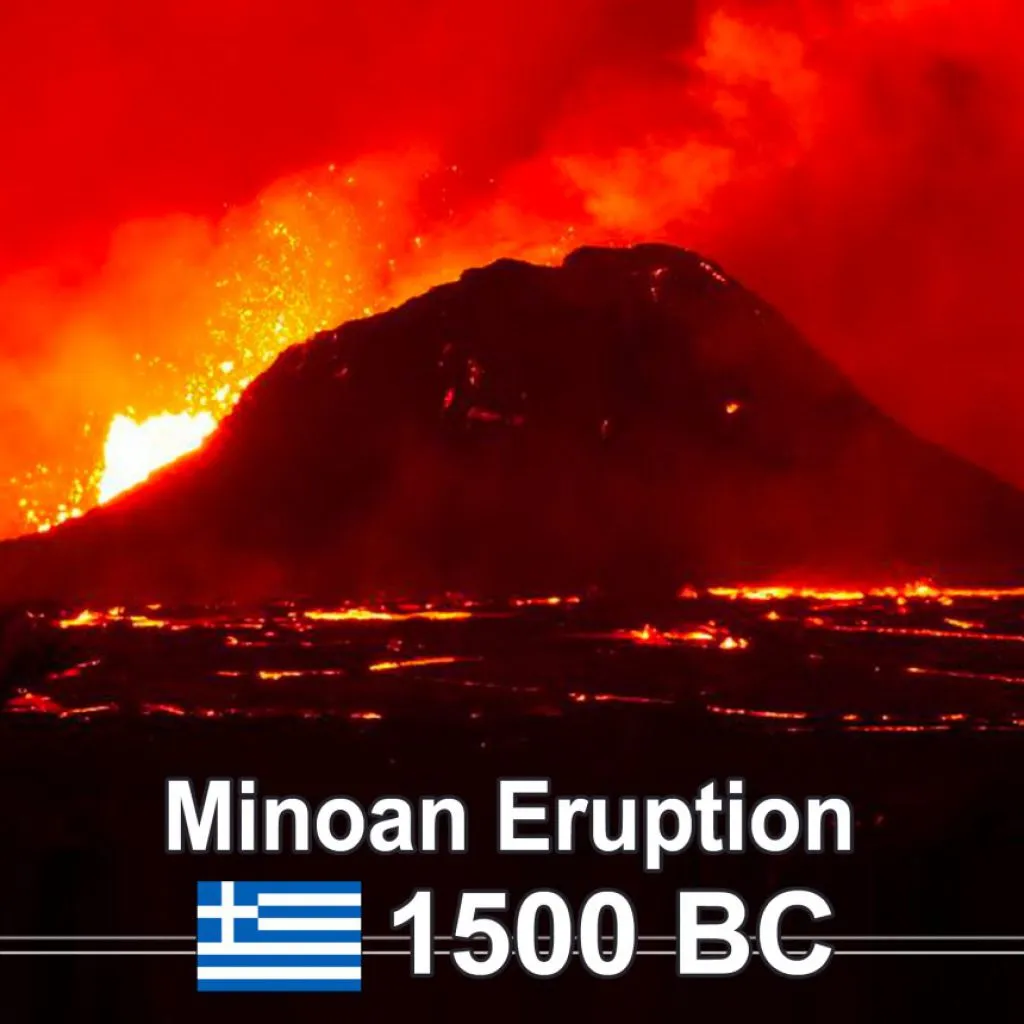
Minoan Eruption
The Minoan eruption of Thera, also referred to as the Thera eruption, Santorini eruption, or Late Bronze Age eruption, was a major catastrophic volcanic eruption with a Volcanic Explosivity Index (VEI) of 6 or 7 and a dense-rock equivalent (DRE) of 60 km3
Dated to the mid-second millennium BCE, the eruption was one of the largest volcanic events on Earth in recorded history. It devastated the island of Thera (now called Santorini), including the Minoan settlement at Akrotiri and communities and agricultural areas on nearby islands and the coast of Crete with a related earthquake and tsunami.
There are no clear ancient records of the eruption, which may have inspired certain Greek myths, caused turmoil in Egypt and been alluded to in a Chinese chronicle.
Geological evidence shows the Thera volcano erupted numerous times over several hundred thousand years before the Minoan eruption. In a repeating process, the volcano would violently erupt, then eventually collapse into a roughly circular seawater-filled caldera, with numerous small islands forming the circle. The caldera would slowly refill with magma, building a new volcano, which erupted and then collapsed in an ongoing cyclical process.
Immediately before the Minoan eruption, the walls of the caldera formed a nearly continuous ring of islands with the only entrance between Thera and the tiny island of Aspronisi. This cataclysmic eruption was centered on a small island just north of the existing island of Nea Kameni in the centre of the then-existing caldera. The northern part of the caldera was refilled by the volcanic ash and lava, then collapsed again.
MAGNITUDE
Research by a team of international scientists in 2006 revealed that the Santorini event was much larger than the original estimate of 39 km3 (9.4 cu mi) of Dense-Rock Equivalent (DRE), or total volume of material erupted from the volcano, that was published in 1991. With an estimated DRE in excess of 60 km3 (14 cu mi), the volume of ejecta was approximately 100 km3 (24 cu mi). If so, the eruption's Volcanic Explosivity Index was 7. The volcano ejected up to four times as much as the well-recorded eruption by Krakatoa in 1883. The Thera volcanic events and subsequent ashfall probably sterilized the island, as occurred on Krakatoa. Only the Mount Tambora volcanic eruption of 1815, Lake Taupo's Hatepe eruption around 180 CE, and perhaps the Baekdu Mountain eruption around 970 CE released more material into the atmosphere during historic times.
ERUPTION DATING
The Minoan eruption is a key marker for the Bronze Age chronology of the Eastern Mediterranean world. It provides a fixed point for aligning the entire chronology of the second millennium BCE in the Aegean, as evidence of the eruption is found throughout the region. Despite the evidence, the exact date of the eruption has been difficult to determine. Archaeologists have traditionally placed it at approximately 1500 BCE. Radiocarbon dates, including analysis of an olive branch buried beneath a lava flow from the volcano that gave a date between 1627 BCE and 1600 BCE (95% confidence interval), suggest an eruption date more than a century earlier than suggested by archaeologists. Thus, the radiocarbon dates and the archaeological dates are in substantial disagreement. It has also been recently suggested that there may be regional variations in the calibration curve which might alter a date by up to 20 years.
In 2012, one of the proponents of an archaeological date, Felix Höflmayer, argued that archaeological evidence could be consistent with a date as early as 1590 BCE, reducing the discrepancy to around 50 years.
Conversely, the radiocarbon dates have been argued to be inaccurate on scientific grounds. That argument has been made, in particular, by Malcolm H. Wiener. The primary problem is that 14C-deficient carbon, sourced from the environment, might easily have affected the radiocarbon dates.
EFFECT ON EGYPTIAN HISTORY
Apocalyptic rainstorms, which devastated much of Egypt, and were described on the Tempest Stele of Ahmose I, have been attributed to short-term climatic changes caused by the Theran eruption. The difficulty with this interpretation is that in the conventional but disputed Egyptian chronology Ahmose I ruled from c. 1539-1514 BCE, whilst the eruption is thought to have occurred somewhere between 1642-1540 BCE.
Alternatively, if the eruption occurred in the Second Intermediate Period, the absence of Egyptian records of the eruption could be caused by the general disorder in Egypt around that time.
USER:
There was a lot more than a simple volcanic eruption going on 3500 years ago.
According to the writings of Hevelius, the Jewish Exodus took place 3506 years ago. This same time frame was given in1602 works of Abraham Rockenbach, De cometis tractatus novus methodicus, "In the year of our world 2453 - as many trustworthy authors, on the basis of many conjectures, have determined - a comet appeared which Pliny also mentioned in his second book. It was fiery red, of irregular circular form, with a wrapped head; it was in the shape of a globe and was of terrible aspect. It is said that the King Typhon ruled at the time in Egypt.
Certain authorities assert the comet was seen in Syria, Babylonia, India, in the sign of Capricorn, in the form of a disc, at the time when the children of Israel advanced from Egypt toward the Promised Land, led on their way by a pillar of cloud during the day and a pillar of fire at night."
Many old authors, Lydus, Servius, Hephaestion and Juctinus also mentioned the comet Typhon. They all described it as an immense globe of fire, who's movement was slow and close to the sun. Its color was bloody; "It was not of fiery, but of bloody redness." They said the object caused destruction with its rising and setting and was the cause
of many plagues, evils and hunger. They also said that if the earth were to meet with Typhon again, a four day encounter would suffice to destroy the world.
The Exodus:
The first visible sign that the Destroyer was near was a fine red dust, coating the land. This same red dust gave the sea, rivers and lakes a bloody coloring. This blooding of the waters was also recorded by the Maya. According to them, "in the days of the great cataclysm, when the earth quaked and the sun's motion was interrupted, the waters in the river turned to blood."
From the Papyrus Ipuwer, "The river is blood....Plague is throughout the land. Blood is everywhere" From Exodus (7:20) "All the waters that were in the river were turned to blood."
Exodus(7:21) The blood was all throughout the land of Egypt....And all the Egyptians digged round about the river for water to drink; for they could not drink of the water of the river."
After the red dust, came the hail of fiery stones. In Exodus 9:8 it is said that a small dust, like ashes of the furnace fell in all the land of Egypt. The dust was the forerunner of the stones. Exodus 9:18
There fell a very grievous hail, such has not been seen in Egypt since its foundations." According to the ancients, these small stones were hot and mingled with fire. Today we would call them meteorites.Ipuwer wrote that the stones and fire from the sky destroyed all of the crops and frightened away all the livestock. The story of hot stones is corroborated in the Mexican Annals of Cuahtitlan. It describes how a cosmic catastrophe was accompanied by a hail of stones. In the oral traditions of the indigenous peoples, there is also stories of a time
when the sky rained fire and hot stones. many cultures from around the world recorded a stick substance the rained down from the sky and at times ignited, creating great walls of fire that traveled across the
land. According to Immanuel Velikovsky, this substance was oil, the same oil we refer to as fossil fuel. Velikovsky believes the oil in the ground was seeded by the passing Destroyer and not the result of decaying matter.
According to the Hebrews, this sticky goo covered the earth and caused fires to burn for seven years. After the fires came the darkness, brought on by a disruption in the Earth's rotation.
Besides darkness, this disruption also caused hurricane winds. They said the wind and darkness lasted for seven days. According to rabbinical tradition, contrary to what the Torah tells us, this plague of wind and darkness was said to killed 49 out of every 50 Israelites and only a small population was left to flee Egypt. An Egyptian hieroglyphic inscription in el-Arish reads: "The land was in great affliction. Evil fell on this Earth. There was a great upheaval in residence...Nobody could leave the palace during the nine days, and during these nine days of upheaval there was such a tempest that neither men nor gods(the royal family) could see the faces of those beside them."
When the Earth was forced out of her regular motion, a shock wave convulsed across the planet that caused a massive global quake. Ipuwer wrote, "The towns are destroyed. Upper Egypt has become waste...All is ruins.""And Pharaoh rose up in the night, he, and all his servants, and all the Egyptians; and there was a great cry in Egypt; for there was not a house where there was not one dead." (Exodus 12:30)
When the world plunged out of darkness, the Hebrews were at the Red Sea, where they say the waters parted, revealing the sea bottom. They said the water stood up has a wall. Could this have been caused by the gravitational pull of the Destroyer? Our tiny moon effects our oceans, now imagine what would happen if a massively dense brown dwarf star was passing by...it would grab the oceans and pull them up to the sky. While the massive tides towered above, a battle went on in the sky. This battle was seen around the world. According to rabbinical literature the night of the great earthquake, the sky was as bright as day, as Typhon (the Destroyer) filled the sky like a fiery dragon. It was said that Typhon, "Out topped all the mountains, and his head often brushed the stars. One of his hands reached out to the west and the other to the east, and from them projected a hundred dragons heads. From the thighs downward he had huge coils of vipers which emitted a long hissing. His body was all wings...and fire flashed from his eyes. Such and so great was Typhon when, hurling kindled rocks, he made for the very heaven with hissing and shouts, spouting a great jet of fire from his mouth.'
Egypt wasn't the only land to fall victim to these plagues, a cataclysmic also struck Palestine, Syria, Cyprus, Mesopotamia, Asia Minor, the Caucasus and Persia. Also, Crete was was overwhelmed by natural upheaval, the volcano Thera erupted and the Indus Valley civilization came to a sudden end. For those who might be skeptical of
the word of the ancients, a few modern scientists have discovered corroborating evidence, supporting the ancients were struck by a global event. Scandinavian scientist, Rutger Sernander discovered that catastrophic climate changes took place in 1500 BC. Careful investigation by W.A. Johnston of the Niagara River bed found the
present channel was cut by the falls less then 4000 years ago. The Bear river delta is 3600 years old. A study by Claude Jones of the lakes of the Great Basin, show the lakes have only existed for 3500 years.
Reginald Daly made observations of beaches around the world and discovered that sea levels dropped 16 -20 feet, 3500 years ago. The evidence our world was struck by a cosmic event is overwhelming and yet people will tell you this is nothing more than an hoax. They will tell you that Immanuel Velikovsky was a fraud and his work was bogus. They will call you a liar when you present the facts or they will try to make you look like a fool. The one thing they can't do is produce evidence to prove you wrong...
because they can't.
























